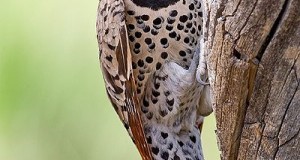 If you observe wild birds, you’ve no doubt marveled at their ability to fly through dense brush without touching a single branch. In NYC, I’ve twice been surprised to see pigeons flying at full speed through amazingly tight spaces when pursued by Red-Tailed Hawks. Bats utilize echolocation to perform similar feats, but with few exceptions (i.e. the Oilbird, please see below), birds lack this adaptation. So how do they do it? According to a recent study (Current Biology, Oct., 2011) at Australia’s Vision Center and the University of Queensland, some species rely upon vision alone.
If you observe wild birds, you’ve no doubt marveled at their ability to fly through dense brush without touching a single branch. In NYC, I’ve twice been surprised to see pigeons flying at full speed through amazingly tight spaces when pursued by Red-Tailed Hawks. Bats utilize echolocation to perform similar feats, but with few exceptions (i.e. the Oilbird, please see below), birds lack this adaptation. So how do they do it? According to a recent study (Current Biology, Oct., 2011) at Australia’s Vision Center and the University of Queensland, some species rely upon vision alone.
“See-Compare-Adjust Course”
Researchers worked with Budgerigars (Parakeets) that had been trained to fly an indoor course that allowed for careful monitoring. They were able to show that the birds used their vision to sense and compare the speed at which they passed background images, and then adjusted their flight path accordingly.
As birds move forward, objects that are near seem to speed by quickly; objects that are further away appear to go by at a slower pace. So, as a bird gets closer to an object, the eye nearest it will perceive that object to be moving faster than objects seen by the other eye. The bird will then veer away from the nearby obstacle to avoid a crash.
This “sounds good on paper”, as they say, but what amazes me is the speed at which birds perform these maneuvers. Add to that the complex, ever-changing environments and wind conditions to which birds in flight are subjected, and you’ll realize what skilled navigators they are.
Monocular vs. Binocular Vision
Budgerigars and most other birds have monocular vision – that is, eyes that are set widely apart on either side of the face. This orientation is ideal for flying as described above, because each eye is usually seeing a different object.
Hawks, herons and certain other predatory birds have, in common with us, binocular vision…forward facing eyes that can focus on a single object simultaneously. This allows for effective hunting. I wonder if they are able to navigate with the same efficiency as Budgerigars (perhaps not – I have observed several hawk-crane-heron accidents). Most fly in relatively open environments, but Sharp-Shinned Hawks and some others are known for pursuing prey through dense tree cover.
Specialized Navigators: Owls, Oilbirds and Swiftlets
 Birds of all kinds have other amazing flight adaptations that enable them to survive. The nocturnal, cave-dwelling Oilbirds and Cave Swiftlets can fly and feed in complete darkness, aided by a form of echolocation similar to that used by bats.
Birds of all kinds have other amazing flight adaptations that enable them to survive. The nocturnal, cave-dwelling Oilbirds and Cave Swiftlets can fly and feed in complete darkness, aided by a form of echolocation similar to that used by bats.
In certain owls, one ear is located slightly higher on the head than the other. Sound reaches each at a slightly (very slightly, I imagine!) different time, and can be used to triangulate the sound’s source. By triangulation, Barn Owls can locate and capture an unseen mouse that is over a football field distant from them! Perhaps this ability explains why Barn Owls are among the most widespread of all birds of prey…I’ve observed them several NYC neighborhoods, and they nest on every continent except Antarctica.
Further Reading
Migration and other amazing navigational feats
Budgerigar Migration: interesting facts and photos
Oilbirds image referenced from wikipedia and originally posted by The Lilac Breasted Roller
Barn Owl image referenced from wikipedia and originally posted by Stevie B
 That Bird Blog – Bird Care and History for Pet Birds
That Bird Blog – Bird Care and History for Pet Birds



